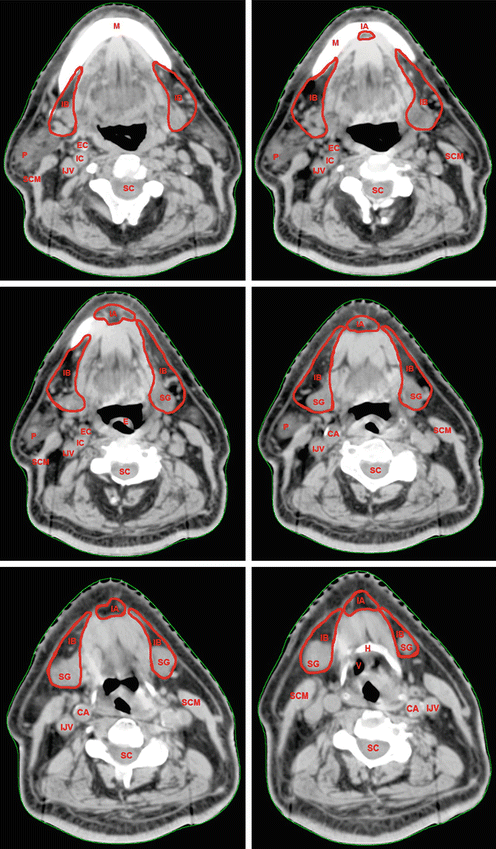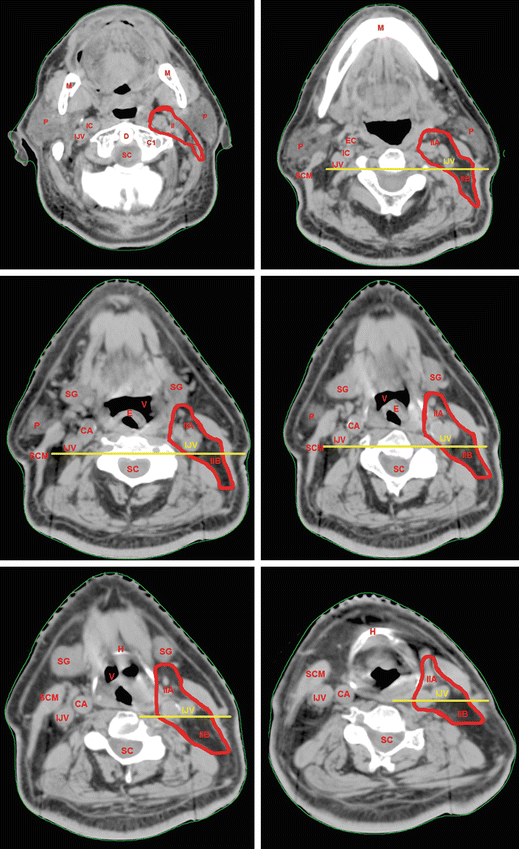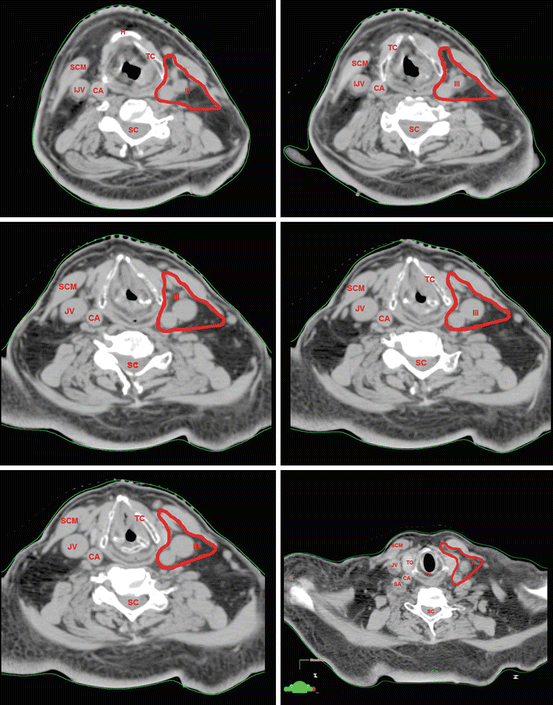Location
Clinically N+ (%)
Clinically N−, pathologically N+ (%)
Glottic larynx
–
15
Supraglottic larynx
39
26
Piriform sinus
49
59
Pharyngeal wall
50
37
Oral tongue
12
33
Floor of the mouth
27
21
Base of tongue
37
55
Tonsil
16
–
2 Evidence-Based Treatment Approaches
Neck irradiation may be performed in negative necks electively (adjuvant or definitive), and in positive necks either preoperatively or postoperatively [10, 11]. Elective neck radiotherapy (RT) has local control (LC) rates similar to elective neck dissection, and neither has an effect on survival [12, 13]. However, Piedbois et al. showed a survival advantage of elective neck dissection over RT in 233 patients with early-stage oral cavity cancers [14]. The decision between RT and dissection is given according to the treatment method for the primary disease. Indications for an elective neck treatment depend on the stage and the grade of the primary lesion. Radiotherapy (RT) (45–50 Gy) is justified in patients with a 20 % or higher risk of occult lymphatic metastatis. Thus, early lesions of the paranasal sinuses, nasal vestibule and nasal cavity, lip, and glottic larynx do not require elective neck RT [15, 16]. The University of Florida published their results for elective neck RT [17, 18]. They observed neck failure in 5 and 21 % of patients who did and did not receive elective neck RT, respectively.
Neck dissection is indicated following RT in patients with multiple, large, and fixated lymph nodes. If positive lymph nodes regress completely after RT, subsequent neck dissection is not necessary [19–22]. The University of Florida recommends following the patients with CT performed after 4 weeks of the last day of RT, and withholding neck dissection if the risk of residual disease is under 5 % [23].
There are two trials showing the efficacy of neck irradiation with a concomitant boost scheme. Peters et al. treated 100 patients with oropharyngeal cancer who had cervical lymph node metastases [24]. Among 62 patients who had complete response to RT, 7 recurred in the neck. Neck control rate was 86 % at 2 years. Subcutaneous fibrosis rate was not different from a group of patients who received RT and neck dissection. Johnson et al. reported complete response in 72 % of 81 patients with lymph node metastases [25]. Among these, 5 % had recurrence in the neck. 3-year neck control was 94 %, and 86 % for <3-cm and >3-cm lymph nodes, respectively. In Mayo Clinic’s study, 5-year neck recurrence-free survivals in patients treated with neck dissection only were 76 % for N1, 60 % for N2, and 69 % overall [26].
If neck dissection is “planned” after RT, doses of 50–70 Gy are delivered according to the size and the mobility of the lymph nodes [27]. If the nodes are fixed and/or the primary disease is treated with RT, the neck should be treated with RT followed by neck dissection. With a planned dissection following a decreased dose of RT, LC is increased, and complications such as fibrosis and cranial nerve palsy are decreased compared to high-dose RT alone.
If RT is to follow surgery, it is generally performed within 4–6 weeks; however, waiting for 10 weeks at most did not affect LC of the neck negatively [27, 28]. In dissected necks with negative margins, 60–65 Gy are prescribed, whereas higher doses are needed for positive margins or residual disease [28–30].
Chao et al. reported the results of 126 patients with head and neck cancer who were treated with IMRT [31]. They observed that most of neck failures were seen within the high-risk region, which was described as CTV1.
As different doses are prescribed for the primary region and the neck according to the presence of residual disease, lymph node metastatis, or extracapsular extension (ECE), Mohan et al. developed “simultaneous integrated boost” in order to be able to prescribe different doses to different regions without decreasing fraction size [32]. Butler et al. defined “simultaneous modulated accelerated radiation therapy ” (SMART) where they prescribed 2.4 Gy to high-risk disease in order to minimize the overall treatment time [33]. In RTOG 00–22 study, patients with early-stage oropharyngeal cancer, who had no chemotherapy, received 66 Gy with daily fraction sizes of 2.2 Gy to primary tumor and metastatic nodes, where subclinical disease received 54–60 Gy with daily fraction sizes of 1.8–2 Gy [34]. They found 2-year local failure (LF) rate of 9 % with grade 2 or higher xerostomia rates of 16 % and other toxicities even less. In the study of Ozyigit et al., 2 and 1.2 Gy daily were prescribed to high-risk and low-risk diseases, respectively [35]. The patients were also receiving chemotherapy. They reported no increase in LF in areas receiving 1.2 Gy daily. However, 2-year disease-free survival (DFS) was lower compared to high-dose areas (78 % vs. 94 %).
The decision for prophylactic neck treatment depends on the probability of occult metastasis . This limit is 20 % or higher for many American centers, whereas in Europe, neck treatment is performed if the risk is 5–10 % or higher [36]. In N0 necks, retropharyngeal (RP) lymph nodes should be included in tumors infiltrating the posterior pharynx wall (e.g., nasopharyngeal, hypopharyngeal, oropharyngeal). In tumors of the subglottic or transglottic larynx, and hypopharynx with extension to the esophagus, level VI nodes should be delineated. In nasopharynx cancer, bilateral levels I–V together with RP lymph nodes should be irradiated. According to Byers, this is also the case for N1 necks without ECE [37].
In the majority of patients with N2b disease, levels I–V should be treated [1]. However, in larynx and oral cavity tumors, one may omit level I and level V lymph nodes, respectively (in case they are not metastatic). This is also the case in postoperative patients. In tumors located in the midline or have bilateral lymph node drainage, contralateral neck should be treated. In patients with neck dissection who have indication for neck irradiation, levels I–V should be treated with previously described exceptions [1].
Lymph node positivity rates of specific regions are shown in Table 3.2 [1, 2, 4–6, 38, 39].
Table 3.2
Lymph node positivity rates of specific regions (%)
Region | Level I | Level II | Level III | Level IV | Level V | RP |
|---|---|---|---|---|---|---|
Nasopharynx | 17 | 94 | 85 | 19 | 61 | 86 |
Glottic larynx | 6 | 61 | 54 | 30 | 6 | |
Supraglottic larynx | 6 | 61 | 54 | 30 | 6 | 4 |
Piriform sinus | 2 | 77 | 57 | 23 | 22 | 9 |
Pharyngeal wall | 11 | 84 | 72 | 40 | 20 | 21 |
Oral tongue | 39 | 73 | 27 | 11 | 0 | |
Floor of mouth | 72 | 51 | 29 | 11 | 5 | |
Alveolar ridge and retromolar trigone | 38 | 84 | 25 | 10 | 4 | |
Base of tongue | 19 | 89 | 22 | 10 | 18 | 6 |
Tonsil | 8 | 74 | 31 | 14 | 12 | 12 |
Thyroid | 0 | 87 | 100 | 100 | 10 |
3 Levels of Drainage for Certain Locations of Tumors
Each head and neck subsite have particular pattern of lymphatic drainage [40]:
Level Ia : This level drains the mid-lower lip, anterior oral tongue, anterior floor of the mouth, anterior alveolar mandibular ridge, and skin of the chin.
Level Ib : These nodes are sentinel to maxillary sinus and oral cavity tumors. They drain submandibular gland, anterior and lower nasal cavity, upper and lower lips, hard and soft palates, nasopharynx, anterior of oral tongue, cheeks, maxillary and mandibular alveolar ridges, medial canthus, and soft tissues of the midface.
Level II : This region contains the sentinel lymph nodes for oropharyngeal, oral cavity, supraglottic laryngeal, hypopharyngeal, and thyroid gland cancers. It also drains lymphatics from the nasopharynx, nasal cavity, glottic and subglottic larynx, salivary glands, paranasal sinuses, face, middle ear, and external auditory canal. Oropharyngeal and nasopharyngeal tumors drain to level IIb lymph nodes.
Level III : These lymph nodes are sentinel for subglottic laryngeal and thyroid gland tumors. They also drain nasopharynx, hypopharynx, oropharynx (tonsils, base of the tongue), supraglottic and glottic larynx, paranasal sinuses, and oral cavity tumors.
Level IV : It drains the larynx, hypopharynx, nasopharynx, and cervical esophagus.
Level V : It drains the nasopharynx, oropharynx (tonsils, base of the tongue), apex of piriform sinus, subglottic larynx, cervical esophagus, thyroid gland, occipital and parietal scalp, postauricular and nuchal regions, and skin of the lateral and posterior neck and shoulder.
Level VI : Prelaryngeal lymph nodes are sentinel for glottic and subglottic laryngeal and thyroid gland tumors. They also drain the hypopharynx, cervical esophagus, and apex of the piriform sinus tumors.
Retropharyngeal Nodes : They are sentinel for ethmoid sinus, nasal cavity, and nasopharynx cancers, but also drain the oropharynx, hypopharynx, supraglottic larynx, maxillary sinus, and soft palate.
4 Radiologic Boundaries for Lymph Node Levels of the Neck
Radiologic boundaries for level I lymph nodes are described in Table 3.3 (Fig. 3.1) [40].
Table 3.3
Radiologic boundaries for level I lymph nodes
Levels
Terminology
Borders
Cranial
Caudal
Anterior
Posterior
Medial
Lateral
Ia
Submental
Cranial border of mandible
Body of hyoid
Platysma muscle
Body of hyoid
Anterior belly of digastric muscle
Ib
Submandibular
Cranialborder of submandibular gland, mylohyoid muscle
Central hyoid bone
Platysma muscle
Posterior border of submandibular gland
Anterior belly of digastric muscle
Mandible, skin, platysma muscle

Fig. 3.1
Delineation of level I lymph nodes. Tip: find C1 transverse process to begin level II in case of N(−); otherwise, find jugular foramen (JF) in N(+) neck (see Fig. 3.6 to see JF) (H hyoid bone, IB level IB, IA Level 1A, SG submandibular gland, P parotid gland, SC spinal cord, IJV internal jugular vein, IC internal carotid artery, EC external carotid artery, CA common carotid artery, E epiglottis, V vallecula, M mandible, SCM sternocleidomastoid muscle)
Radiologic boundaries for level II lymph nodes are described in Table 3.4 (Fig. 3.2).
Table 3.4
Radiologic boundaries for level II lymph nodes
Levels
Terminology
Borders
Cranial
Caudal
Anterior
Posterior
Medial
Lateral
IIa
Upper jugular (jugulodigastric)
Superior border of transverse process of C1 vertebra
inferior border of hyoid bone
Posterior to submandibular gland
Posterior to jugular vein
Medial border of ICA
Medial border of SCM muscle
IIb
Superior border of transverse process of C1 vertebra
Inferior border of hyoid bone
Posterior to jugular vein
Posterior border of SCM muscle
Deep cervical muscles
Medial border of SCM muscle

Fig. 3.2
Delineation of level II lymph nodes. Tip: yellow line just at the posterior edge of IJV divides level II into A and B. (SG submandibular gland, P parotid gland, SC spinal cord, IJV internal jugular vein, IC internal carotid artery, EC external carotid artery, CA common carotid artery, E epiglottis, V vallecula, M mandible, SCM sternocleido mastoid muscle, H hyoid bone, D dens of axis, C1 C1 cervical vertebrae)
Radiologic boundaries for level III lymph nodes are described in Table 3.5 (Fig. 3.3).
Table 3.5
Radiologic boundaries for level III lymph nodes
Level
Terminology
Borders
Cranial
Caudal
Anterior
Posterior
Medial
Lateral
III
Mid-jugular (jugulo-omohyoid)
Inferior to body of hyoid
Inferior to cricoid
Anterior border of SCM muscle
Posterior border of SCM muscle
Medial border of ICA, deep cervical muscles
Lateral border of SCM muscle

Fig. 3.3
Delineation of level III lymph nodes (SC spinal cord, IJV internal jugular vein, CA common carotid artery, SCM sternocleido mastoid muscle, H Hyoid bone, TC Thyroid cartilage, Cr Cricoid cartilage, TG Thyroid gland, SA Scalenus anterior muscle, JV Jugular vein)
Radiologic boundaries for level IV lymph nodes are described in Table 3.6 (Fig. 3.4).
Table 3.6
Radiologic boundaries for level IV lymph nodes
Level
Terminology
Borders
Cranial< div class='tao-gold-member'>Only gold members can continue reading. Log In or Register to continue
Stay updated, free articles. Join our Telegram channel

Full access? Get Clinical Tree

 Get Clinical Tree app for offline access
Get Clinical Tree app for offline access
